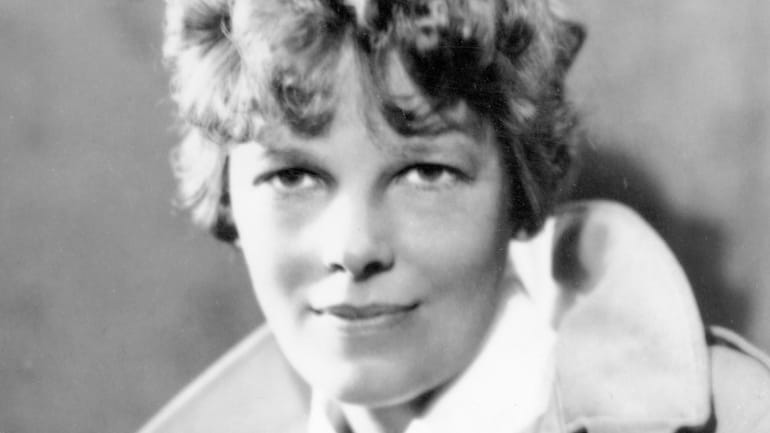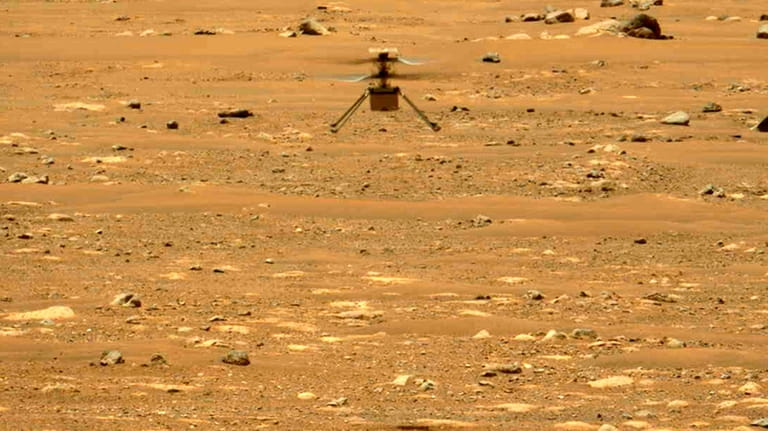Amelia Earhart, the Mars copter and lessons in pushing limits

Amelia Earhart was among the first aviators to champion commercial air travel and literally went where no woman had gone before. Credit: AP
Ingenuity died in the heavens this week.
On Mars, specifically.
This is not some grasp at celestial metaphor. Ingenuity, the little helicopter that hitched a ride to the Red Planet on the Perseverance rover three years ago this month, suffered a broken rotor on a flight this past week and won’t be flying anymore.

The Mars Ingenuity helicopter hovers above the surface of the planet during its second flight on April 22, 2021, in this image from NASA. Credit: AP
But the little copter-that-could leaves a rich legacy — an unexpected 72 flights, proof that such flying is possible in the thin Martian atmosphere, bragging rights as the first helicopter or plane to launch from another planet, and a giant shoutout for the durability of humble components in billion-dollar operations, like Ingenuity’s off-the-shelf lithium-ion batteries and 2015 cellphone processor that survived all that time amid the high levels of radiation on Mars.
Back in April 2021, NASA officials called Ingenuity’s first Martian flight a “Wright brothers moment.” The phrase recognized the importance of the first-ever feat, but its resurfacing this week landed with a bittersweet jab amid news about another pioneering moment in aviation — Amelia Earhart’s attempt to fly round-the-world.
She and navigator Fred Noonan disappeared somewhere over the southwestern Pacific Ocean on their way to Howland Island, one of the region’s many tiny coral atolls, on July 2, 1937. What happened to them and their Lockheed 10-E Electra — along with the where, when, how and why — has been one of humanity’s great mysteries for nearly nine decades.
All sorts of theories have been expounded and mostly debunked. Some have been what you might call aviation-related, citing possible navigation errors or weather conditions while trying to pinpoint the spot where she crashed.
Others are more fanciful. They survived the crash but died as castaways on some remote island. Or were captured and executed by the Japanese.
And some theories were tin-hat crazy, like the proposition that they had been abducted by aliens. Or, a personal favorite, that Earhart had survived and was living under an alias in New Jersey.
Failure after failure has not dissuaded the searchers, the latest of whom is an ex-U.S. Air Force pilot named Tony Romeo. Romeo says his marine robotics company captured a sonar image of a plane resting on the bottom of the Pacific somewhere within 100 miles of Howland Island. The three-month expedition took place last year and the scratchy gold image does resemble a plane. Romeo contends it shows the distinctive fin stabilizers on the back of Earhart’s aircraft.
Perhaps. But also, perhaps not. Many experts are scoffing.
It will take time and tons of money for Romeo to prove his claim. Which means the mystery will persist.
And that’s fine. We humans do love mystery. In real life or fiction, mysteries are good for the soul. We want to solve them, but enduring mysteries remind us that not everything must or can be explained. And that can be healthily humbling.
Earhart’s allure guarantees the quest to solve her mystery will endure. After a slew of aviation firsts, including being the first female aviator to fly solo across the Atlantic Ocean, Earhart became a national sensation with lecture tours, endorsements for luggage, cigarettes and clothing, and a memorable nickname, Lady Lindy. For years, she was a go-to for biographies in grade school.
Earhart was among the first aviators to champion commercial air travel and literally went where no woman had gone before. And as is often the case with trailblazers, whether they be human pilots or tiny copters, we learned from what they did.
Twin reminders this week that our instinct to push our boundaries sometimes ends in triumph, and sometimes perhaps at the bottom of the ocean’s floor.
Columnist Michael Dobie's opinions are his own.

